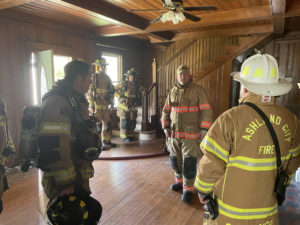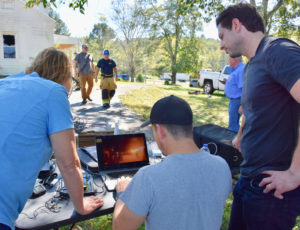The National Fire Sprinkler Association (NFSA) paved the way for a successful Home Fire Sprinkler Coalition (HFSC) live-fire video shoot on location in Ashland City, Tennessee, last week. But this was no ordinary fire recording. HFSC conducted the shoot to produce an unprecedented, virtual reality, 360-degree house fire and sprinkler educational video.
When it is completed later this year, viewers will be able to experience the fires without and with sprinklers as if they were inside the burning house. Using a VR headset, they can watch from any angle and hear the fire crackle. They’ll see flashover and watch as the flames and smoke spread. They’ll understand how the high heat from the fire activates the sprinkler and watch as the sprinkler controls the blaze. A 2D version will be created for free, on-demand access via Internet. Viewers will also be able to compare damage in the two rooms after the fires are out.
To help ensure HFSC captured the footage, NFSA teamed up with the Ashland City Fire Department. Together they secured a single-family house earmarked for demolition and obtained permission to use it for live fires. The home was ideal because it had two rooms that could be set up as identical living rooms. The NFSA team included President Shane Ray, VP/Executive Officer Vickie Pritchett, Director of Field Operations Gary West and Regional Manager Brian Biggs. Chief Chuck Walker led the Ashland City Fire Department team, which also provided suppression.
“We shot an actual house fire with and without fire sprinkler activation as we have done for many educational projects,” explains Peg Paul, HFSC communications manager, who oversaw the project and is producer of the video. “But this time was different because we were shooting in virtual reality, 3D video.”
The set-up, pre-production, fires and video shoot all went very smoothly, thanks to a lot of experience. That ranges from live fire demonstrations and outfitting structures for flashover to sprinkler installation and tricky on-location video production.
Even with the A-Team on board, video shoots are stressful. “With live fire burns and video productions we only have one chance to get it right,” Paul explained. “This was my first experience working with a crew using specialized equipment to shoot virtual reality, 360-degree video. This technology presented new challenges as well as new opportunities. We had to think about the entire room – all four walls, the ceilings and the floors. We had to anticipate and be prepared for how the fires would burn, how quickly the smoke would block the shot and how to best capture the sprinkler activation.”

The crew sets up one of the VR 360 cameras before the flashover fire. This camera captured the fire spreading. As planned, the heat of the fire damaged the camera, but the images were saved.
While they were experienced in shooting virtual reality video, this was the video crew’s first time working with live fire. They spent time researching different cameras and prepared to sacrifice at least one. HFSC had back up plans, including use of a standard camera placed behind heat-resistant glass and shooting through a hole in a wall. The crew spent a lot of time thinking through the anticipated smoke and fire behavior in each room and how best to respond to each fire.
“Everyone working on this project was a true professional,” Paul said, “I am especially grateful to Shane, Vickie, Brian and the rest of the NFSA team who stepped up. This summer, when I asked Vickie if NFSA had a home we could use for the shoot, she immediately said yes and said NFSA would provide all the resources we needed for it, including working with Chief Walker and the Ashland City Fire Department. When we sent Brian the long list of things we needed done to the rooms and all the items to furnish them, he didn’t miss a beat. He kept reassuring us that whatever we needed, it would get done, and it did.”
NFSA, one of HFSC’s founding members, donated all resources to prepare and set up the rooms including construction materials, labor, duplicate furniture, carpet and accessories. The rooms were painted and the fire sprinkler was installed in one of the rooms. “Each and every time we participate in burns like this, we are reminded that fire is indeed fast and seeing that fire sprinkler activate inspires us all,” said NFSA President Shane Ray. “We are proud to support HFSC and play a major role in creating this next level of technology that we can all share.”

The room after the fire sprinkler activated. Viewers will see the entire room and can compare the rooms after the fires.
It’s no accident the Ashland City Fire Department wanted to support this home fire sprinkler education project. Chief Walker was the recipient of the 2014 Bringing Safety Home award, jointly presented by NFPA Fire Sprinkler Initiative and HFSC. The Chief was recognized for his outstanding efforts and diligence promoting the importance of home fire sprinklers. Ashland City passed an ordinance requiring all homes be protected with sprinklers in 2001. Today 49% of all Ashland residential units are sprinklered.
In many ways, this project reflects team spirit. The video production is funded through a grant to HFSC from State Farm. The virtual reality resource and its introduction to the U.S. fire service is funded through a FEMA Fire Prevention & Safety Grant. HFSC’s new educational tool will make powerful, sharable virtual reality education possible for any fire department.
HFSC produced a short video about the VR educational kit: https://www.youtube.com/watch?v=78tivhclUZQ



